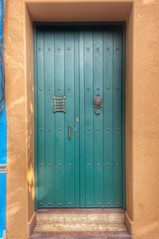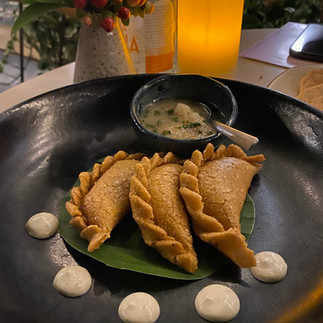cartagena de indias, colombia
- Sherry Brecher
- Mar 18, 2024
- 6 min read
Updated: Mar 19, 2024
Counterpoint to my usual travel style, I didn't do a whole lot during my two weeks in Cartagena. I mainly worked on my tan, read a bunch of books, took lots of naps, walked on the beach, spent quality time with my family and ate my body weight in ceviche.
That said, everything I did see, do and consume was wonderful!
Below is my guide to the sights, sounds and flavors of this coastal Colombian gem.

EXPLORE
OLD TOWN (AKA OLD CITY, WALLED CITY, HISTORICAL CENTER, EL CENTRO)
The first thing I noticed within the confines of this Walled City were the bright, colorful doors and intricate knockers, which served as a charming entryway into the soul of Cartagena's eclectic Old Town.
In addition to doors, the narrow streets were full of modern shops, boutique hotels, exquisite restaurants and a vibrant nightlife. The architecture and vibe felt a little like if New Orleans' French Quarter and Havana had a love-child.

GETSEMANÍ
Next-door to Old Town, was its edgier sibling, Getsemaní. This artsy, semi-residential enclave is famous for its street art. Formerly a seedy area, full of prostitution and crime, Getsemaní is now a hip place to soak up culture, drink rum cocktails and interact with local artists.

LA TUNA FEST
Not to be confused with the fish, a tuna is a group of university students from Spanish-speaking and Latin American countries who sing and play traditional instruments. The second International University Tunas Festival was hosted in Cartagena's Historic Center whilst I was visiting, which meant that there were lots of parades and entertaining street performances.
ROSARIO ISLANDS
A visit to Cartagena would not be complete without venturing offshore to this 27-island archipelago. The journey, by boat, takes less than two hours. Although it's choppy and wet, it's well worth it!

Isla Grande, AKA Escobar Island, was once a place of escape for the famous drug baron. Here the Cocaine King built La Casa Grande, his 300-bedroom secret party mansion. After his death, in 1993, and the gradual collapse of the Medellín cartel, the Colombian government bought the island. El Patrón's former island hacienda is now abandoned, only inhabited by squatters and a family of wild pigs.

During your boat tour, I recommend stopping by Aura Beach Hotel, on Isla Barú, for lunch in a rustic, yet chic, thatched-roof tiki hut, overlooking the sea.

Given the opportunity, have a delicious piña colada, shaken up in front of you, by a floating bartender, in a canoe filled with spirits and garnishes.
LA BOQUILLA
This stretch of sand, just off the tourist trail is worth a visit, if for no other reason than to see a functioning city self-contained on a beach. You name it, it's happening here - police patrol, trash collection, restaurants, city bus stops, taxi service, paratriking, kite surfing, photo shoots and commerce. Be warned though, a cacophony of hawkers, touting everything from cervezas and ceviche to jewelry and knock-off Ray-Bans, will pester you.
If you're lucky enough to catch a youth football beach game, you'll be in for treat. These hearty kids have to contend with heat, sand, no boundary lines and traffic.
EAT/DRINK:
Foodies, rejoice! If there's a South American paradise for gastronomy, Cartagena is it. Hidden amongst the cobbled streets of the Walled City are some of the most talented chefs in Colombia, serving up delicious food in alluring restaurants.
*Be sure to book far in advance, as many of these hot tickets fill up quickly.
My favorites were...
This came recommended to me by three different people and it lived up to the hype! The food was yummy and beautifully plated, the cocktails list was extensive, the service was top-notch and the live music was delightful. On a windy evening, sit in the courtyard at your own peril (below are all the items that I got assaulted by).

You'll find Alma tucked inside the incredibly chic Casa San Agustin, a boutique hotel where my interior dreams have been realized. Chef Eljach blends Japanese, Italian and French culinary influences together with local ingredients and anything that lives in the sea.

Another star in Cartagena's dining constellation is this quirky, fanciful and very cool restaurant. It felt a little Alice in Wonderland-y, in a fun way. The food was an exotic blend of Colombian, Caribbean and Spanish and the dance shows throughout the meal were a bonus.
This is a slightly less formal dining option than some others on this list. It has a warm atmosphere, with great service and fun live music. Start with the tuna tataki.
The restaurant's colorful and laid-back ambiance, great food and occasional live music make it a favorite rooftop dining spot for both locals and tourists.

This delightful terrace overlooks the port where party-goers embark on their booze cruises. Go for the people watching, stay for the polpo starter and mujarra with creamy coconut rice.
Housed within the Casa Lola hotel, in the happening Getsemaní neighborhood, you'll find this decadently decorated space. If you're traveling with picky kids, the hamburger is served in an elaborate and unconventional way.
Have a drink in the garden at this award-winning colonial luxury hotel located in the heart of Cartagena's historic center.

Sofitel revived this former monastery, which dates back to 1621, but has maintained many of the historical elements and quirks. Every day at 6pm, waiters dressed as monks put candles on the tables in the courtyard to an accompaniment of chapel music.

This buzzy, but relaxed, jungle atmosphere is perfect for lunch or dinner. The staff were friendly, but a tad slow.
Take a walk along the wall at sunset. If you can get in, have a sundowner at Cafe del Mar. This place gets PACKED, so book in advance, via What’s App, from their website.

Expect no-frills, filling Colombian food. The menu is limited, but the food is great and reasonably priced. You'll find mostly locals and backpackers in here.
ROOFTOPS
We attempted to go to the Movich Hotel rooftop, but it was closed for a private event. So we went to the Sophia Hotel to try to go to their rooftop, but it was at capacity. The La Cata rooftop, in the Santa Catalina Hotel was hosting a wedding. We finally found a spot at the Mirador Gastro Bar rooftop, but there was no sunset view.
OTHER CONSIDERATIONS
Celele, voted one of Latin America's 50 Best Restaurants, was on my list, but I had to cancel my reservation. Apparently this is not to be missed though. Likewise, I did not make it to Alquimico nor El Barón (both also on the 50 Best List), despite my best intentions.
With its gorgeous Old City, funky neighborhoods, picturesque beaches, and top-notch culinary and nightlife scene, Cartagena ticks all the boxes for that South American vacation you’ve been longing for.
KNOW BEFORE YOU GO:
Airline Quirk: If you fly Avianca to/from Colombia, they will make you fold your blankets and put them behind your backs for take-off. No idea why.
Weather: It's always hot and humid in Cartagena. And the sun is super strong! But, from January to March, the winds provide some relief and also eliminate flying bugs. Rainy season is considered to be September-November, with October being the rainiest month.
Transportation: The Old Town/Getsemaní are best explored on foot. Outside the central area taxis and Ubers are widely available and affordable (a couple bucks for a 15-20 min drive). Be warned that the cars are small and junky, often held together by duct tape.
Mobiles: I was told, by many people, including locals, not to have my mobile phone put in plain site. But I must admit that I wasn’t as careful as I should have been. All was fine in my case, but it's always good to be vigilant.
Safety: Despite its dark and complicated past, Cartagena is one of the safest big cities in Colombia. Crime rates have dropped drastically. It felt safe to me and I didn't run into any issues, but like any city, be cautious and careful with your belongings and have your wits about you.
Water: I wasn’t cautious about drinking from the tap and brushing my teeth with tap water and I didn't get sick.
Tipping: Not necessary, but appreciated.
Language: The language barrier is REAL! A lot of locals do not speak English. I would suggest downloading the Google Translate app.
Currency Confusion: Colombia’s official currency is the peso (abbreviated as COP). Prices in Colombia are marked with a dollar sign, but remember that you’re seeing the price in Colombian pesos, not USD. The notes official denominations are $1,000, $2,000, $5,000, $10,000, $20,000, $50,000, and $100,000, but are labeled as 1 mil, 2 mil, 5 mil, 10 mil, 20 mil, 50 mil and 100 mil. And often times the amounts are written with periods instead of commas. So ‘20 mil’, 20.000, $20,000 and 20 (veinte) are all the same thing.















































Comments